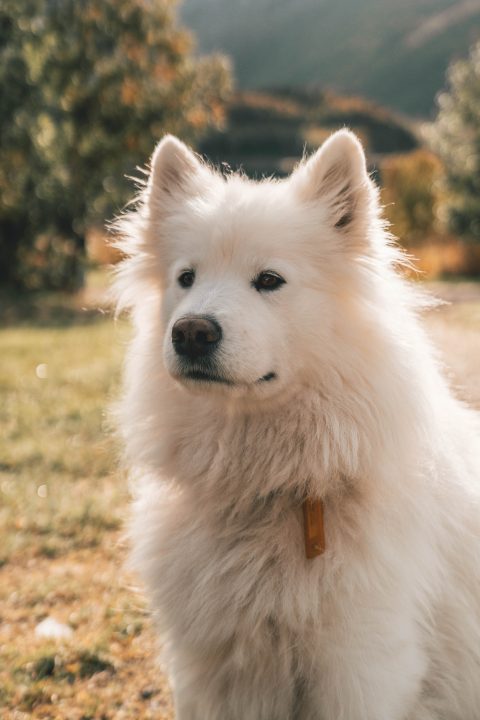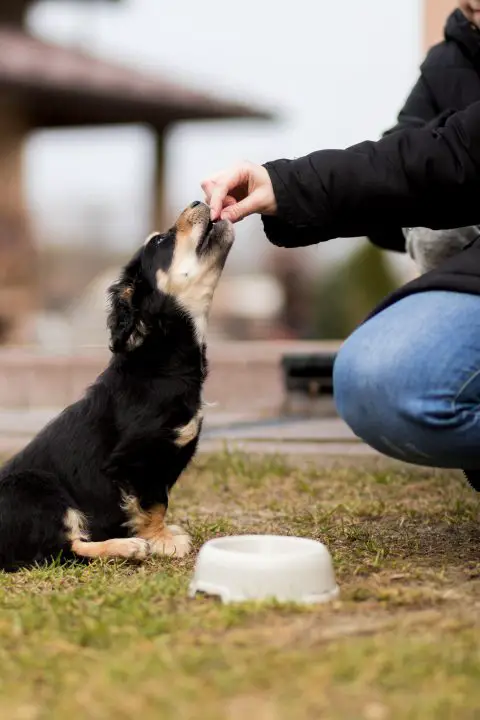Looking after your pooch can be a tricky job. Especially when it comes to protecting them from catching illnesses. Dogs love to explore and so naturally they can pick up different illnesses and issues.
This is particularly the case when it comes to their skin. You can recognize that a dog has formed a skin condition because a lot of the time they will scratch or bite a lot.
If you do notice them itching or gnawing at their fur, it is useful to understand a little bit about the most common skin conditions found in dogs and how to treat them.
If you have started to notice anything strange on your dog’s skin, or you notice that they are scratching a lot, don’t worry too much! In this article I am going to tell you what your dog’s skin should look like, some of the main skin conditions in dogs, and how best to deal with these so that you can keep your furry friend as happy and healthy as possible!

Table of Contents
- What should my dog’s skin look like?
- Signs of a Skin Condition in My Dog
- Dog Skin Conditions
- Final Thoughts
- FAQs
What should my dog’s skin look like?
If your dog is healthy and has nothing to worry about, there are a few ways to identify that your dog’s skin is normal and healthy.
All dogs are unique, and therefore so is their skin. However, there are some general signs to recognize. These may suggest that your dog has developed a condition in their skin.
If your dog is healthy, they should display:
- Pink or black skin – depending on the pigmentation of your dog and their breed, dogs will either have a pinkish tone to their skin or they may have black. In some cases your dog may have a combination of both.
- No crusting or spotting – your dog should have no visible scabbing, scaling, crusting or itching of the skin. They should also be free of black or white spots and there should not be any hot or inflamed areas.
- A shiny and thick coat – whilst the thickness will depend on breed, they should have a healthy and full coat of fur. They should not have any noticeable bald patches, dandruff, or broken hairs.
- No fleas – it is important to regularly inspect your dogs for fleas. A healthy dog should not be displaying any signs of fleas in their fur or on their skin.
- Shedding – most dogs will shed a lot heavier in the spring and autumn. But if you notice a considerable amount of shedding throughout the year then this should be something to investigate.
- Smooth skin – dog’s skin should be smooth and bump free. This will also lead to a clean coat that is in good condition.
Signs of a Skin Condition in My Dog
Whilst there are many ways to identify healthy skin on your dog, it is also important to note that there are a few signs that may indicate a potential skin condition in your pup:
- Excessive scratching – do you notice your dog is scratching a lot, pulling out their fur, or biting at a particular area? This could be a sign of a skin disease.
- Poor coat – if their fur coat is looking dull or scruffy, this could indicate an underlying illness and may be worth looking into.
- Skin cover on the inside of ears – lots of dog ear problems can be linked to skin problems when it comes to dogs. If you notice skin covers not only the outside but the inside of your dog’s ears, this may be something to investigate.
- Brownish discharge in ears – does your dog have a brown or reddish discharge in their ears? Then this is something you should address. If they keep playing with their ears or shaking their head then it is an indication of a further issue. You should take them to the vet.
Dog Skin Conditions
Now that you know some of the key signs that indicate whether your dog is healthy or not, it is important to know what these are and how they are caused.
Dry Skin on Dogs
Dry skin on dogs can be caused by a number of things, much like dry skin on humans
A lot of the time, dry skin is caused by their home environment. During winter this is more prominent. As we have heating on and dogs are spending a lot more time at a higher temperature when in the house, this can cause their skin to dry out and become itchy.
Further to this, the combination of hearsh weather outside and warm weather inside can cause skin irritation, similar to how it can with humans.
Dry skin can also be caused by a specific shampoo. If you notice your dog is experiencing dry skin a lot more in those few days following a wash, it may be useful to try a new shampoo. Or speak to your vet and get a recommendation on shampoos for dogs who experience dry skin.
Dry skin is not typically something to worry too much about. It can be easily treated. Sometimes dogs enjoy a new shampoo that provides more moisture.
If the skin condition does not seem to go away with a new shampoo, you can try using a dehumidifier in your house, particularly in the winter. This may help them to become more comfortable and will prevent their skin from becoming dry.
If the problem persists, it is a good idea to speak to your vet to see if they can diagnose the potential cause.

Dog Hair Loss
There are a number of reasons your dog may be experiencing hair loss. This could be due to them pulling it out themselves, and in most causes this is the likely cause. This can happen from things like dry skin, fleas, bacteria, or ringworm. This in itself is an indication of another skin condition, but hair loss itself is not the core problem.
However, hair loss can come if your dog has alopecia. This is an illness that also affects a lot of humans and other animals.
Alopecia can be caused by a number of factors. Common skin allergies can result in alopecia. In this instance it is a case of identifying the allergy and hopefully curing this will also help reduce the alopecia.
Over-grooming can also be a cause of alopecia. If your dog is over-grooming itself due to an ache or a pain, or if you yourself are over-grooming your dog, this can result in hair loss.
Finally, alopecia is most commonly caused by stress or anxiety. If you notice alopecia in your dog and your dog is acting strangely or stressed, this may be something worth taking to the vet. Alopecia comes from a high level of discomfort. Resolving this will not only help the alopecia go away, but will lead to a much happier pooch.
The treatment of alopecia will depend on its severity. But in most cases your vet will prescribe a relevant solution to help prevent the hair loss whilst also trying to target the key cause and removing this from your dog’s life.
Skin Parasites
It is no secret that almost all pets face the fear of skin parasites. Whilst we do all we can to avoid them, sometimes it is inevitable.
Fleas, mites, ticks, and lice are all common parasites found on dogs, particularly in the warmer months. This is because dogs are so adventurous. They not only play in long grass where these parasites hide, but they also love to socialize with other dogs. This greatly increases their chances of transmitting a skin parasite.
Whilst skin parasites sound very serious, in most cases they are quite common and reasonably easy to treat. It is important to treat them as soon as you notice them because they will multiply. They can risk infesting your home which can make the job a lot harder when trying to remove them.
Most can be treated successfully, but it can be a long process. Skin parasites can cause itching, redness, scabbing, inflammation. If you notice flea dirt then this is also a clear indication of skin parasites.
You can find out more about the removal of fleas on dogs.
Skin Allergies in Dogs
If you notice your dog scratching a lot but notice no signs of a parasite, this may be due to an allergy. There are a number of signs that may indicate your dog has an allergy:
- Excessive scratching
- Excessive licking
- Red or scabbed skin
- Itchy ears
- Runny eyes
- Sneezing and coughing
- Vomiting
- Diarrhea
- Paw chewing
Any of the above can indicate that your pet has an allergy.
Allergies are usually caused by an environmental factor, fleas, or food allergies.
Environmental allergies can be due to both indoor and outdoor environments. Similar to human allergies, regular outdoor occurrences such as pollens, grass, trees or fleas can trigger them. These can be difficult because many outdoor causes are things that we have no control over.
However, dogs may also develop allergies from indoor environments. This can come from things like cleaning products, mold, shampoo, and house dust.
Identifying the cause of the allergy is the most important thing to do first. Whilst we have less control over outdoor environmental factors, ensuring you aren’t using any cleaning products in the house or shampoos on the dog can be a great way to prevent allergies. You can try out different products to see if this helps. Keeping a clean home can also help with this and also help prevent fleas.
Dogs may also develop an allergy towards fleas. This is known as flea allergy dermatitis. This happens when your pet has an allergic reaction to flea saliva after the flea bites the animal.
This will cause excessive itching all over the animal, but is most commonly found on the base of the tail.
Regarding fleas, if your dog has developed an allergy to the flea bites, it is crucial that you contact your vet. They can provide a solution to help cure the allergy.
Finally, your dog may develop an allergy towards the food they are eating. Dogs eat all kinds of things when they are exploring outside. A lot of the time this is out of our control. However, if your dog has developed an allergy to the food you give them, this is something you can tackle.
A lot of the time you can help resolve a skin allergy by removing the cause. But in some cases this may be out of your control. You may need some prescribed creams or medications to tackle the allergy, much like with humans.
If you have noticed an allergy in your dog but cannot target the source, it is best to speak to your vet. Your vet will be able to identify it as soon as possible.
You can find out more about dog allergies and their causes on our blog: Why is My Dog Itching?

Final Thoughts
Noticing a skin irritation on your dog can be quite upsetting, not only because the cause can be confusing, but also because your pet may be in a lot of discomfort.
It is always important to first consider fleas or a potential injury. Investigate your dog for any signs of either of these.
There are many ways to not only identify if your dog has healthy skin, but to also recognise any potential skin conditions. If you do notice itching, sore, redness, spots, or scabs, it is best to contact your vet for a professional opinion.
For excessive hair loss, consider potential causes such as dry skin or over-grooming. If not, it is likely your dog has alopecia and this is also something that your vet can investigate properly and help to prevent.
Try not to worry too much. But for the best cure, get professional help if you notice any discomfort in your pet. They will be back to their happy and healthy self before you can say fetch!
FAQs
Dermatitis (there are several types!), ringworm, bacterial skin infections, yeast infection, mange, hives, and seborrhea are common skin diseases in dogs.
Redness, itching, hair loss, or unusual lumps are all signs of a skin condition in your pup.





